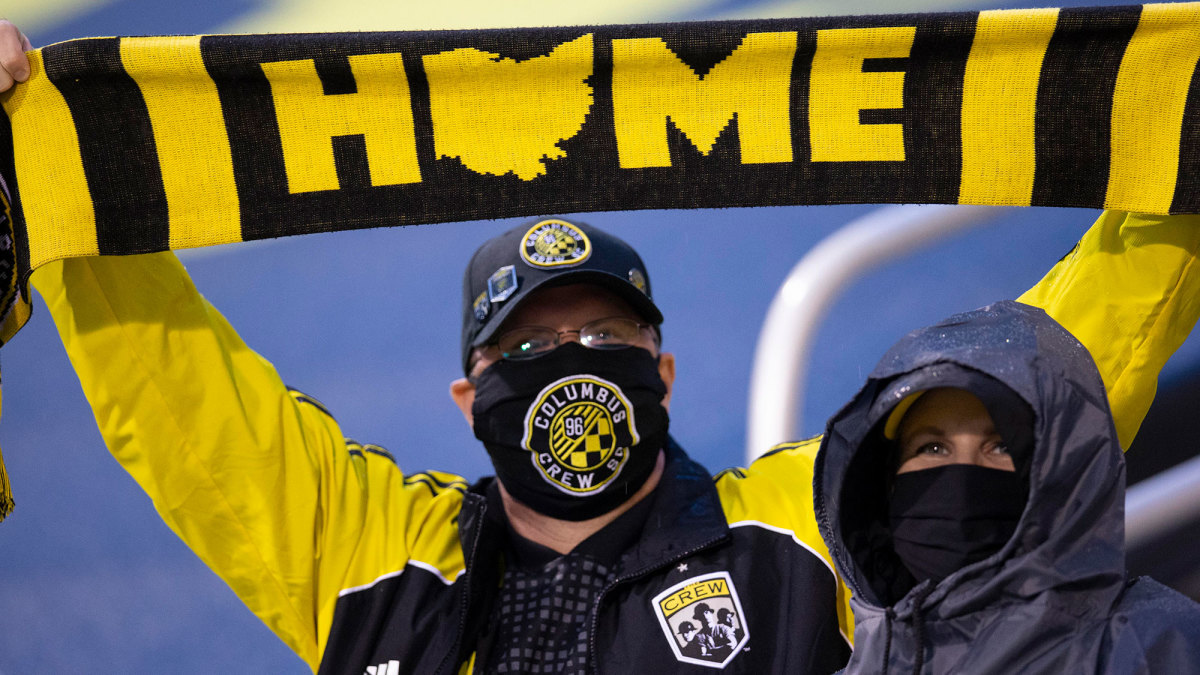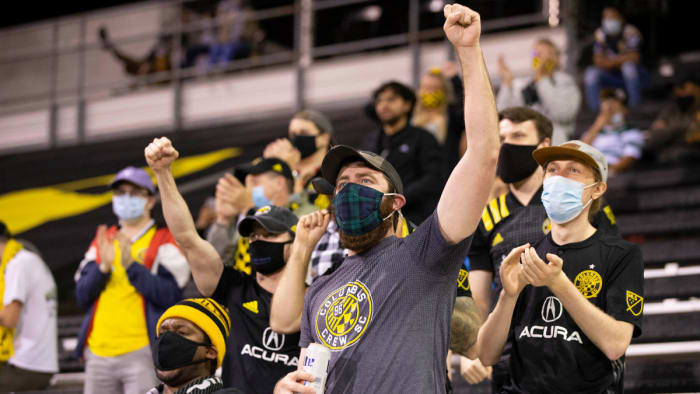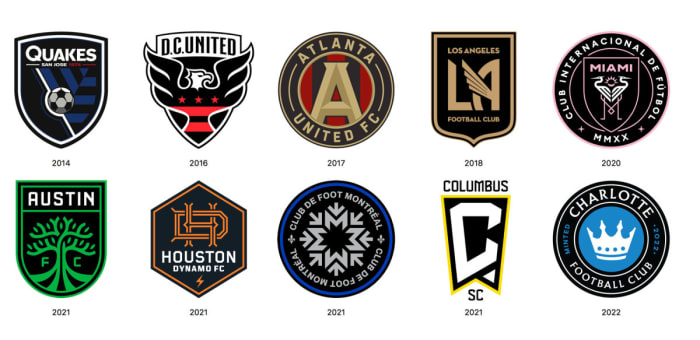Crew's Change to Columbus SC the Latest in MLS Branding Conformity
Since changing names and logos is all the rage these days, let’s agree to tweak the meaning of the three stars in Major League Soccer’s newish crest. Instead of “club, country and community,” they’ll now symbolize the principles that underpin the league’s branding, its structure and the message it sends to dedicated fans. They now stand for “conformity, cloning and cowardice.”
Those three stars represent the Holy Trinity of American soccer. Within three there is one—the single entity. That unique league structure cultivates a collective and inevitable deference to the whole, as well as a persuasive impulse to fall in line, blend in and follow. Standing out or spending more, even if it leads to more distinctive teams, better TV ratings or that elusive Concacaf Champions League title, would constitute an assault on the inviolable single entity. As the seasons go by, it seems like MLS has become a character in Christopher Nolan’s Tenet, a system governed by reverse entropy where disorder decreases, and the individual components settle in and become more and more alike.
The new owners of the rebranded Columbus Crew, now Columbus SC, were heroes two years ago when they cemented the team’s rescue from oblivion. Dee and Jimmy Haslam and Dr. Pete Edwards were ushered in on a wave of unprecedented activism, an organic effort called ‘Save the Crew’ that injected the organization with a level of authenticity and grassroots cachet unique in American soccer. Those owners deserve considerable credit. But MLS’s first club survived because it was sustained by its supporters, and it was the best story in the sport. The value and visibility of the new owners’ investment increased because of those fans and their devotion. It was compelling evidence that clubs derive worth and meaning from the traditions they maintain and the communities they represent.
Never has that been more clear than in the past month, as owners and executives who lost track of their mission as stewards of community assets were reminded in no uncertain terms that their mandates have limits. The European Super League was a declaration of war against the notion that clubs derive worth and meaning from traditions and community. For those 12 teams from England, Italy and Spain, growth and globalism were the primary drivers. Appealing to fans around the world, even if it meant severing ties to home, was the goal. The local die-hards would fall in line, of course.
Except they didn’t, at least in England. They protested. They revolted. Along with politicians and the media, supporters reminded their club stewards that sustenance comes from the roots. It’s incomprehensible, yet somehow not surprising, that the Crew’s owners—beneficiaries as they are of the hard work and dedication of local fans and officials—ignored those scenes from around (and in Old Trafford’s case, inside) English stadiums as they pursued a rebrand nobody wanted, and did so without consultation.
As news broke Sunday evening of the overhaul, which features the elimination of the 25-year-old Columbus Crew name (the club claims ‘Crew’ will still be a nickname going forward) and a dull, minimalist pennant logo that’s a confusing downgrade from the almost-universally liked striped and checkered roundel, Columbus fans released a statement saying that no supporters group was consulted or involved in the rebrand.
“The Crew has been the club’s named heart since its inception. It has served as our rallying cry when we had to save the team from relocation,” the Nordecke wrote. “We condemn these changes and, more importantly, the lack of transparency in this process.”
Their opinions probably weren’t considered for the same reason that the 12 European rebels didn’t ask for feedback on the Super League idea: The locals will always fall in line. It’s global branding that matters.
We hear it over and over again, from MLS team after MLS team: “We want to be a global brand.” When unveiling the incongruous and derivative St. Louis City name last summer, owner Carolyn Kindle Betz said she wanted MLS to put her market “on the international map,” and that she was intrigued by the branding “once I started to get educated on why ‘City’ is an international name.” Columbus SC president and GM Tim Bezbatchenko, who was quoted in Monday’s official announcement, used the phrase “global stage of soccer” to describe his club’s ambitions.
Columbus and St. Louis won’t be global brands. Chicago, Boston and Washington are barely global brands.
To be a global brand, to appeal to a global audience, the club name must follow British/European conventions, apparently. Never mind that the New York Yankees, Dallas Cowboys and Los Angeles Lakers are world-renowned, that MLS’s three Cascadia clubs (Sounders, Timbers and Whitecaps) do pretty well, or that the LA Galaxy remain MLS’s only legitimate global brand (maybe it’s not about the name). In their rush to attract new fans—die-hards be damned—and without regard for the crushing monotony engulfing the league, MLS owners are ignoring names that might stand out in favor of the safe and same. They’d all rather sound like they were from England or Spain than from a place like Columbus or St. Louis. And so the Crew and Montreal Impact are gone, as are the journeys, roots and traditions both names embodied. In addition, every one of the 11 expansion teams that’s joined the league since 2015 has chosen a British/European name. There are three Citys, two Uniteds, four FCs, one SC and one Inter.
Selecting City FC in place of something more local and original is lazy and shortsighted, as it simply highlights MLS’s single-entity structure and the reluctance to deviate. But erasing a name like the Crew, which had so much legitimate history and then became inextricably tied to the club’s dramatic rescue, is almost an insult. The new logo is bland and meaningless, and robs the league of a distinctive mark. Quick, are there any other teams in Ohio that use a ‘C’? It all highlights the fact that MLS teams don’t seem to be encouraged or permitted to have their own identities, or their own quirks or customs. In the end, they’re appendages of the same whole, incentivized to follow the same trend in one single-file, inauthentic pursuit of authenticity.
It’s been pointed out over and over: this manifests on game day, when MLS often takes on the look of the intramural league it apparently aspires to be. The team names and logos are infuriatingly similar (the new Crew badge joins nine others released since 2014 that are predominantly black) and the uniforms are interchangeable. Turn on an MLS game and guess who’s playing. That strategy obviously does wonders for ratings.
The team formerly known as the Montreal Impact ditched their blue-and-black stripes (at least there used to be some blue) for an all-black kit. Atlanta’s five red stripes remain, but they’re imperceptible. The team now appears all-black (or all-white on the road). Austin FC’s new home uniform looks all-black from the back, sides or at a distance. It wears all-white on the road. While the San Jose Earthquakes are finally back in blue shirts, it took several years after a reversal of the 2014 promise that they’d be primarily a blue team. Despite selling pink, Inter Miami wears all-white or all-black. LAFC is all-black. The New York Red Bulls now frequently dress in all-black, perhaps as an homage to their more successful rivals in Washington. Charlotte FC has hinted at an all-black uniform. And Columbus ditched their iconic yellow jersey this season for, you guessed it, white or black.
It’s like MLS has become a youth recreational league, where kids bring their single, reversible jersey to the field each Saturday. The clubs are homogeneous constructs that allow for games to be played and CCL games to be lost. Too many—a handful of exceptions remain—get away with being something other than living, breathing entities with their own unique DNA. But the trajectory isn’t good, and the only traditions that seem to be worth sticking to are those that aren’t ours. Instead, the idea appears to be to celebrate the league—the whole—rather than to encourage teams to launch and then adhere to their own identities or birthrights. MLS is the global brand. It’s the only brand.
More Soccer Coverage:









